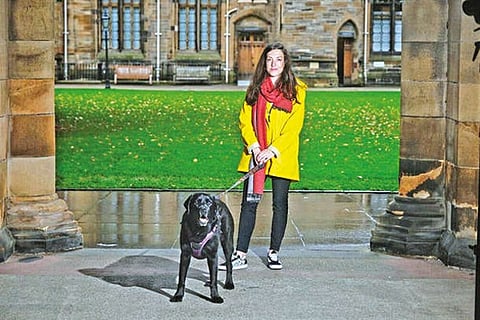

New York
Maybe that’s why the possibility of a “DogPhone” briefly entranced the media world. Who wouldn’t want to take that call? But the new research that inspired those stories, led by Ilyena Hirskyj-Douglas, an assistant professor at the University of Glasgow, was mostly aspirational.
The study only involved one dog. The device was not an actual phone nor is anything of the kind close to the market. And the results were, at best, inconclusive.
Using a ball equipped with a motion-detecting device that triggers video calling, Dr. Hirskyj-Douglas, whose specialty is animal-computer interaction, gave her 10-year-old Labrador retriever, Zack, the power to call her by just moving his toy.
“I thought something like this could help dogs in some way to have more control and have choices,” Dr. Hirskyj-Douglas said in an interview. “We decide so much of their lives that may be having this choice alone is kind of exciting in itself.”
The research, published last month in the journal Proceedings of the ACM on Human-Computer Interaction, took place over the course of 16 days, with variations in the sensitivity of the device. Zack was not trained to use the so-called DogPhone, the researchers said.
During the experiment, Zack called Dr. Hirskyj-Douglas about five times a day and more than 50 times in all. Almost all of the calls appeared to have been made by accident, the study said. “Dog was playing with his pig and accidentally nudged the ball,” the record of one 30-second call reads.
“Dog called by accident (climbing onto the sofa) and then went to sleep,” reads the next, lasting 16 seconds. And in dozens of calls, the dog was asleep when he nudged the motion sensor into action. “Dog sleeping cuddling the ball.”
A leading animal behaviorist, Dr. Patricia McConnell, was skeptical about the study. “A sample of one — one person and one dog — does not a study make,” Dr. McConnell said, “and I wish there had been more effort to train the dog to use the device instead of hoping he’d figure it out.”
But she said the authors were “to be commended for their interest in finding ways to give dogs more agency in their lives, especially when left home alone.” She said the study raises interesting issues. “Do our dogs want to hear from us when we’re away from home? Or would they say, ‘Don’t call me, I’ll call you?’”
In the paper, Dr. Hirskyj-Douglas and her colleagues acknowledged their limits in understanding what a dog meant, or didn’t mean, to do. “It is possible that we humans might not know what an animal’s intentions are, or how they would interact with computer systems intentionally,” they wrote.
In the study’s final days, interactions with Zack were longer, and he called more often, whatever his intent.
The pet surveillance business is booming. As products with cameras, speakers, and GPS devices have proliferated, an increasing number of pet owners are turning to devices that let them be with their pets, even when they’re not physically in the room.
Last year, the pet tech market value topped $5.5 billion, according to an industry report by the research firm Global Market Insights, which projects that the market will swell to more than $20 billion by 2027.
Top-selling products include collars and toys equipped with GPS trackers.
Visit news.dtnext.in to explore our interactive epaper!
Download the DT Next app for more exciting features!
Click here for iOS
Click here for Android